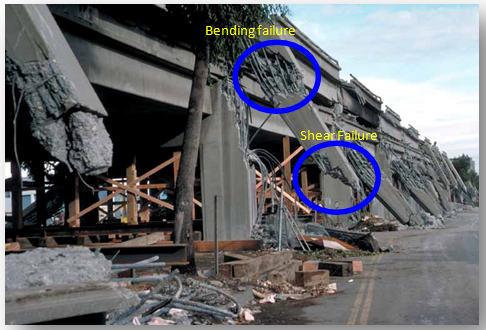Bridge failure during earthquake and it's mitigation
Major type of Failures
Lifeline structures are those which are directly related to the facilities for existence of society. Nowadays many cities are facing problem to maintain the lifeline structures after the earthquake event. These structures are very important and have to be safe.
There are many lifeline structures among them bridge is also a very important lifeline structure that provide commuting and also transportation of foods, oils, water etc. History of bridge failure starts before 1907 when Qbec bridge fail. There are many failure modes of bridge, main two types of them are:
 |
| Photo: collapse of cypress street viaduct (http://pubs.usgs.gov/dds/dds-29/web_pages/oakland.html) |
Shear Failure:
When earthquake event happens at that time due to the shaking of the ground structure feels the large lateral load depends up on the structure’s self weight, amplitude of ground acceleration, soil condition etc. Total load it has to resist as horizontal force so shear force on the column will increase and across the limit of capacity of the column section. When there is the diagonal crack on the structure then we can say there is shear failure. Due to the lack of transverse reinforcement it occurs generally within the ¼ of height from the ground level.
Bending failure (buckling):
During earthquake horizontal force acting on the structure, in bridge structure most of the structural weight is concentrate on the top of column so due to the shaking and displacement more than usual bending moment will apply to the section of column. When excessive bending will apply then section cannot bear and firstly more loads on outer longitudinal reinforcement if load is more than the capacity of reinforcement then it starts to buckle. Due to lack of the longitudinal reinforcement and also the transverse tie reinforcement at that reason this failure occurs. It is also depends on the section and length ratio or slenderness of the column, column with more slenderness ratio or long column will fail faster under this phenomenon. Buckling failure is the main failure for the truss bridge also where when the compression force on any compression member exceeds the capacity of that member then it starts to buckle. Most of the truss bridges fail under the buckling failure mode because steel have good enough tensile strength than compressive strength.
One mitigation method used to prevent such failures.
There are many mitigation method used to increase the seismic performance of structures. For mitigation of concerned failures we have to consider the weak points and then strengthen on those areas. During design and construction we have to concentrate on key areas of failure.
 |
| Strengthening of column |
Shear failure can reduce by providing the sufficient transverse bars in the area of more shear zone. We can provide the additional transverse bars on the column by jacketing or by chipping and inserting as like the old one. We can also reduce the shear failure by increasing the shear area i.e. cross section. Addition of longitudinal bars also contributes to the shear strength of column. During the construction we have to care about the curtailment of the lap bars from the foundation.
Bending failure occurs due to the insufficient steel reinforcement. Mitigation of such failure is by providing excessive longitudinal reinforcement either during the construction or by steel jacketing for the existing structures. For the slender column casing will provide both longitudinal reinforcement and larger cross section which reduce the slenderness of the column. Also the link of the columns provides more strength on bending y sharing of forces. For truss bridges we can provide more compressive strength by other material on composite section or addition of the member. We can also reduce the compressive force by linking of the members that will reduce the member length also reduce the slenderness.






No comments: